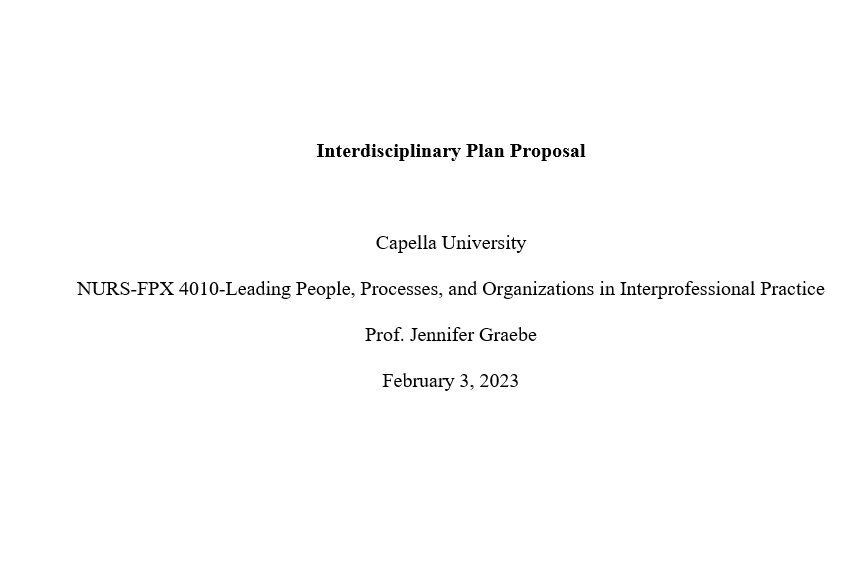NURS-FPX4010_Te_Assessment 3-1 solution.docx
Interdisciplinary Plan Proposal
Capella University
NURS-FPX 4010-Leading People, Processes, and Organizations in Interprofessional Practice
Prof. Jennifer Graebe
February 3, 2023
Interdisciplinary Plan Proposal
Striving to improve patient outcomes and attain organizational goals makes interdisciplinary collaboration a priority for healthcare providers. The collaborative practices remind nurses and other professionals about their roles in participating in larger organizational efforts designed to enhance the quality, safety, and cost of patient care. Wrong medication administration is among the issues that require healthcare professionals to create a shared vision and team goals.
The problem encourages nurses, physicians, pharmacists, and others to participate in interdisciplinary practices to enable them share expertise and maintain a sense of collegiality across the continuum. This plan addresses the need for healthcare professionals to participate in training designed to equip them with knowledge and skills in effective information flows when administering medications.
Objectives
- To discuss the impact of interdisciplinary collaboration in sustaining quality and safe practices.
- To use the training and education session to strengthen knowledge and skills in identifying and intercepting errors.
- To emphasize the relevance of shared vigilance when handling medication.
Questions and Predictions
- Will the team respond positively to calls for interdisciplinary collaboration when administering medications? The prediction is that the audience will recognize the value of team-based functions, attitudes, and behaviors in addressing safety concerns within the clinical environment.
- Will the training help improve care outcomes? The prediction is that nurses, physicians, and pharmacists will acknowledge the significance of team efforts in identifying risk factors and sharing perspectives into evidence-based strategies for preventing wrong medication administration (Savva et al., 2022).
- Does interdisciplinary collaboration enhance vigilance when administering medications? The prediction is that the audience will participate in role plays designed to equip everyone with practical skills for monitoring and preventing medication errors. The outcomes include enhanced commitment to using team-based approaches to identify and intercept risks associated with wrong medication administration.
Change Theories and Leadership Strategies to Improve Care Outcomes
Preventing medication errors requires leaders to initiate changes characterized by clarity of strategic priorities and the need for collective buy-in. The Plan-Do-Study-Act (PDSA) provides a framework for identifying action steps appropriate for facilitating effective change process (McGowan & Reid, 2018).
The model promotes collaborative practices where nurses, physicians, and pharmacists share perspectives on evidence-based strategies for preventing medication errors. The leader encourages collective involvement in planning, trying interventions such as double-checking, observing outcomes, and using the lessons to enhance vigilance across the continuum (Kim et al., 2020).
The transformational leader is appropriate to communicate a shared vision and remind the care team about values, behaviors, and attitudes that make everyone responsive to the rights of safe medication administration. The leader uses person-centered approach to allow everyone to share suggestions about pathways for enhancing the quality and safety of patient care.
With transformational leadership, there are opportunities to share details of an intervention such as double-checks, implications on patients, organization, and the care team, and efforts necessary to achieve the intended results.
For instance, this plan highlights the need for an interactive environment where everyone gets the chance to familiarize with efforts necessary to prevent wrong medication administration. The leader will motivate everyone to uphold positive values and behaviors that demonstrate willingness to improve standards of medication administration.
Team Collaboration Strategy
The team has nurses, physicians, a nurse manager, clinical assistants, and pharmacists. The team’s frontline roles during medication administration make them appropriate for identifying and intercepting risks that may undermine the quality and safety of patient care. A key collaborative strategy is establishing an open and transparent environment (Manias, 2018).
The approach encourages everyone to share suggestions on best practices for using interdisciplinary collaboration to enhance adherence to the rights of safe medication administration. An incident that happened at Dorn VA Medical Center in South Carolina highlights the need for interdisciplinary collaboration to enhance vigilance when administering medications.
A nurse administered multiple doses of pegfilgtastim instead of filgrastim, which caused the patient’s death and a settlement of $800,000 (Sneed, 2019). The patient developed pulmonary toxicity leading to severe acute lung injury. The scenario explains the need for collaborative efforts including double-checks that enable nurses to intercept errors.
Resources Required
Adequate resourcing is a priority for the organization to make meaningful progress towards preventing medication administration errors. Administrative, technical, and financial resources will make the training and education effective in promoting excellent collaboration across the continuum.
The organization will need a nurse educator to guide the team through role plays and other sessions. Role play guides, medication safety checklists, and a copy of the case study are also necessary to make the process successful.
Table 1
Resources
| Resource | Description | Cost ($) |
| A nurse educator | The educator will share knowledge, skills, and experiences about medication administration errors and strategies such as double-checks for strengthening adherence to rights on safe medication administration. | 1,500 |
| Medication safety checklists | The checklists make the audience familiar with standards associated with safe medication administration. | 200 |
| Pocket handouts | The handouts have details of the training sessions and recommendations intended to enhance the safety and quality of safe medication administration. | 200 |
| Role play guides | Guide the care team on practical approaches for understanding the procedures, standards, and behaviors appropriate for enhancing vigilance when administering medications. | 300 |
| A case scenario | An incident that happened at Dorn VA Medical Center in South Carolina where a nurse administered multiple doses of pegfilgtastim instead of filgrastim. | 200 |
| TOTAL | 2,400 |
References
Kim, M. S., Seok, J. H., Kim, B. M. (2020). Mediating role of the perceived benefits of using a medication safety system in the relationship between transformational leadership and the medication-error management climate. Journal of Research in Nursing, 25(1), 22-34. https://journals.sagepub.com/doi/pdf/10.1177/1744987118824621
Manias, E. (2018). Effects of interdisciplinary collaboration in hospitals on medication errors: An integrative review. Expert Opinion on Drug Safety, 17(3), 259-275. https://pubmed.ncbi.nlm.nih.gov/29303376/
McGowan, M., & Reid, B. (2018). Using the Plan, Do, Study, Act cycle to enhance a patient feedback system for older adults. British Journal of Nursing, 27(16), 936–941. https://pubmed.ncbi.nlm.nih.gov/30187794/
Savva, G., Papastavrou, E., Charalambous, A., Vryonides, S., & Merkouris, A. (2022). Exploring nurses’ perceptions of medication error risk factors: Findings from a sequential qualitative study. Global Qualitative Nursing Research, 9, 1-10. https://journals.sagepub.com/doi/full/10.1177/23333936221094857
Sneed, J. (2019). $800,000 settlement from fatal drug mix-up at VA Hospital. Abraham Watkins. https://www.abrahamwatkins.com/blog/2019/01/800000-settlement-from-fatal-drug-mix-up-at-va-hospital/



